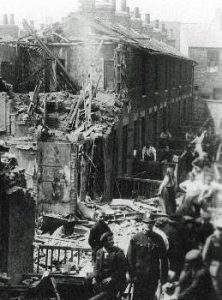
In June 1915, Hull experienced its first and deadliest Zeppelin raid.
Britain was the first county in history to experience widespread strategic bombing of civilians. Two large, rigid air ships, named Zeppelins L3 & L4, after their creator Count Ferdinand Von Zeppelin, dropped bombs on eastern coastal towns in January 1915. They caused casualties in Great Yarmouth and Kings Lynn.
As in the Second World War, the Humber estuary and River Hull made the City an easy target for aircraft to find and attack. Hull’s industry at the time of the raid was dominated by shipping, fishing and its associated trades. In June 1915, Hull’s population was about 291,000 and the City was exporting 56,760 tons of coal to foreign countries. It proved a large, lucrative target’.
Hull quickly established its own Anti Aircraft Unit to defend against attack. Stentorian Buzzers, or steam whistles were created to warn citizens of attack. Hull created the largest buzzer ever called ‘Big Lizzie’ and the ‘Hull Mail’ reported the following on 25th January 1915 – “ Arousing the Public in the event of certain happenings, for which the Germans will be responsible, the public at Hull are to be warned by the shrill blast of steam whistles. The steam organ valve whistles are being supplied by Messers George Clark and sons, Waterhouse Lane. The type to be used in Hull are 6 inch in diameter.” (Hull’s ‘Big Lizzie’ Buzzer below).
The author, JR Tolkein, experienced the 1917 Zeppelin Raids, whilst a patient at the Brooklands Hospital, in Hull. He later helped develop Hull’s early warning air raid defences. As a battle experienced Signals Officer, he was attached to the Headquarters of the Humber Garrison and commanded a Royal Engineers outpost in the Post Office, in Roos. He then transferred, as Signals Officer instructor, with the 3rd (Reserve) Battalion Lancashire Fusiliers, a training battalion. His attachment to the 9th Battalion Royal Defence Corps during the winter of 1917-1918, meant he supervised essential, often coded, communications in the crucial approaches to the Humber Estuary.
Zeppelin raids caused widespread fear among the civilian population and during 1915 careful preparation was made to manage the impact of air raids. Hull was divided into six districts – West, North West, Central, North East, East and the River section. Air raid drills were established and if an alarm was raised, 3,000 volunteer Special Constables would turnout to patrol the streets and ensure all lights were put out. Lights on the ground could help Zeppelins work out where they were, so it was important to have a complete blackout. Hundreds of Boy Scouts were used as dispatch riders, messengers and stretcher bearers. During 1915, 25 dressing stations were established in all parts of the City, staffed by Doctors and Members of the St John’s Ambulance Association to administer First Aid. By 1916, Britain also developed guns and searchlights to help defend against Zeppelins. They realised that the Zeppelin balloons were vulnerable to explosive shells which set light to the Hydrogen inside. Hull’s defences for the first two years were controlled by General Ferrier and the practice was to sound the alarm as soon as aircraft were sighted. However, when Major General Sir Stanley Von Donop took over control, alarms were not sounded until danger threatened the City. This saved much inconvenience.

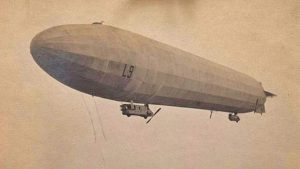
The Zeppelin’s route to Hull was anything but direct. Because of fog, it had already abandoned its initial mission to reach London. It then flew over Norfolk and started its final run on Hull after making landfall near Bridlington.
19:25 – The first warning of a possible pair of Zeppelins came from intercepted wireless traffic. The crafts were somewhere out in the North Sea.
21:30 – Major General Ferrier, commander of Humber defences, ordered all lights in Hull extinguished. (Nordholz AeronauticumCopyright: Nordholz Aeronauticum)
22:20 – Airship seen at Flamborough head
22:30 – Seen at Hornsea
22:40 – Seen at Withernsea
23:00 – Over West Ella, moving eastwards towards the city following the railway lines then veered towards the Humber estuary.
23:45 – L-9 was spotted above Hedon. Summary
Hull Zeppelin raid: 6/7th June 1915
Casualties: 24 people dead and 40 wounded
About 40 bombs dropped on the city
The midnight raid lasted 30 minutes.
The first of eight Zeppelin raids on Hull, began on 5/6th June 1915 and the lighting restrictions imposed made Hull “the darkest city in the Kingdom” for the rest of the war. Capable of travelling at around 85 miles per hour and carrying up to two tons of bombs, Zeppelins wreaked havoc on a largely unprotected Hull. Dropping incendiaries and explosives from heights of around 3,000 feet, they sparked raging fires, damaging many buildings, including the Holy Trinity Church. These air attacks were a new and terrifying experience for Hull civilians. There were no Air Raid shelters, people used Pickering Park and Mr TR Ferens East Hull stables or hid under the stairs as protection from this ‘death from the skies’. The Guildhall basement later a shelter. Lack of knowledge intensified fear. Parents told their children to be quiet or whisper, in case they attracted a bomb. Clocks were stopped to avoid their ‘ticking’ giving a signal to the enemy. While many of the air raids were aimed at Hull’s docks, the bombs inevitably fell on the overcrowded houses nearby. This caused great panic and hardship to the densely packed communities.
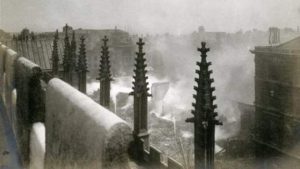
The bomb near the Holy Trinity church (now Hull Minster) set fire to Davis’s drapery store and the nearby Fleece Inn.
Demetrius Franks, the licensee, and his family were in the cellar when the bomb struck and escaped injury.
It was initially thought that there had been no loss of life, but 10 days after the fire, a woman’s body was found under the debris. She was not identified nor did anyone report her missing.
(Photo: Hull Museums Copyright: Hull Museums)
When a photographer captured the scene from the church roof at 10:00 on Monday 7 June the ruins were still on fire.
Then the wind began to gently veer round to the opposite direction causing the smoke to blow up at the camera.
“Thus a fire six or seven hours later would have probably consumed this large and historic building,” he concluded. As it was the damage was estimated at £34,000.
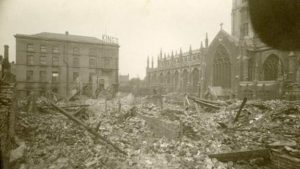
An incendiary bomb (and possibly an explosive device as well) fell near to Holy Trinity Church where the people of Hull had worshipped for more than 600 years.
(Photo: Hull Museums Copyright: Hull Museums)
The incendiary started a fire and it was reported that the heat within the church during the blaze “was terrific and the lead of some of the stained glass windows melted”.
Fortunately, during the raid the wind blew from the north west – away from Holy Trinity – thus saving both the church and the neighbouring King’s building.
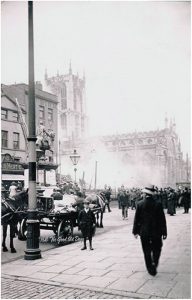
“I remember going there with my brother and sister, ” she said in Keep The Home Fires Burning by local historian John Markham.
“There were rolls of cloth, all smoking and rolls of ribbon. There was a policeman on duty and we asked if we could have some ribbon.
“He said yes and he’d reach it down for us. We got ever so much ribbon. It was all debris, really, and the policeman let us take some.”
In all, there were 51 air attack warnings and at least eight air attacks on Hull during the First World War. Over 160 Hull citizens became casualties in these air raids during World War 1.On one particular Monday there were 14 false alarms.
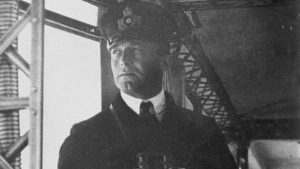
Nordholz Aeronauticum Copyright: Nordholz Aeronauticum
Extract from The Zeppelin in combat- a history of the German naval airship division 1912-1919 by Douglas H Robinson:
“The shortness of the June night, and high temperatures persisting after sundown, made an attack on London hazardous, so Mathy decided to bomb Hull.
“Mist blanketed land and sea, and only after a painstaking two-hour search with parachute flares did Mathy recognise Bridlington and from this point of reference set a course for Hull.” Kapitanleutnant Heinrich Mathy was born on 4 April 1883 in Manheim, Germany. His father was a bank director. He became feared and revered as one of the finest Zeppelin pilots and commanded L-9 from 8 March to 23 June 1915. He went on to be commander of the L-13 until April 1916. Mathy then took over the L-31 until he was shot down over Potters Bar on 2 October 1916. He had crossed the North Sea on a mission to bomb London.
He is buried at the German military cemetery at Cannock Chase.
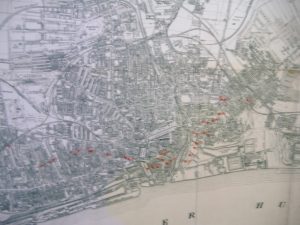
1. The first air raid in Hull occurred on Sunday 5th June 1915 at midnight. The alarm buzzers had previously blown five times before and as nothing had happened, many people ignored the alarm. The Zeppelin L.9, commanded by Captain, Heinrich Mathy, had been prevented from reaching London by high winds. It was spotted flying over Hedon at 11.45pm, and arrived over the sleeping City of Hull, two minutes later. The air raid lasted 30 minutes, cruising back and forth over the city, dropping 13 high explosives and 47 incendiaries. These bombs in sequence hit Constable Street, Coltman Street, Campbell Street, South Parade, Porter Street, Queens Street, Blanket Row, East Street, and Waller Street. The last bomb fell in the Humber Dock, damaging a cargo ship called the ‘Crocus’. Forty shops were destroyed, including the large Edwin Davis shop in Queen Street.
BOMB! Various locations. Bombs were recorded at:
Bright Street – the premises of Palmer’s grocers was destroyed.
Dansom Lane – a saw mill and timber yard destroyed.
Milton Street – incendiary fell in St Mary’s Roman Catholic school yard.
Danson Lane – burned out Lear’s Stables with a “considerable fire”.
Clarence Street – incendiary burned out, no damage.
East Street – explosive bomb demolished two houses. It killed Edward Jordan (10) in number 11, his parents were seriously injured and taken to Naval hospital. Mr and Mrs Hill killed at Number 12.
Victoria Dock – an incendiary in Victoria Dock fell on Swedish ship lying in river basin. Ship’s deck slightly damaged.
Tower Street – Wade’s Timber Yard bomb severely damaged railway line and bashed holes in the walls of neighbouring warehouses.
BOMB!
St Thomas’ Terrace, Campbell Street, Hull
The effects of an explosive Zeppelin bomb are clear in these pictures.
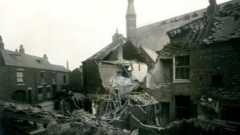
It shows Numbers, 1, 2 and 3, St Thomas’ Terrace, off Campbell Street.
The gap in the centre was house number 2, in which William Walker (60) was killed along with his daughters Alice (32) and Millicent (17). A third daughter May (18) was seriously injured.
Alice’s body was blown onto the aisle roof of St Thomas’s Church, a distance of 30 feet (9m). Millicent’s was blown into a yard at the rear of the house.
Mr Hatfield of the railway police lived in number 3 and although it was badly damaged and almost demolished he, his wife and four children escaped alive.
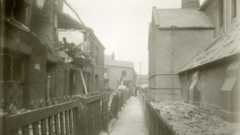
BOMB!
Various locations
Constable Street – bomb number 27 hit lower floor of No 109½ Constable Street. Two cars burned out and garage was almost burned out.
Coltman Street – incendiary at number 153 fell through roof on to partition wall and through floor of landing. Fire extinguished by neighbours, not much damage.
South Parade – incendiary at number 50 fell through roof and ceiling, setting room on fire and burning to death Maurice (11) and Violet aged (8).
BOMB! Five boys escape
An incendiary bomb hit 102 Great Thornton Street, the home of Harris Needler.
In one of its rooms five boys were sleeping, two of them in a bed that was struck by the bomb. In this remarkable photograph you can see the iron of the bedstead is bent and one of the boys is sitting at the scene of their lucky escape.
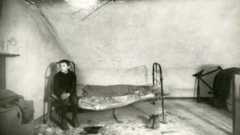
The hole caused by the device is immediately above him. All five boys escaped unhurt.
However, the bomb penetrated the floor and landed on on a bed in the room below occupied by Mrs Needler, who survived despite suffering serious burns.
BOMB!
Craven Street Football Ground
The bombing raid lasted about 30 minutes – with the first device hitting the city at about 11:45pm on Saturday 6th June and the last one at quarter past midnight on Monday 7 June.
The fourth bomb, an incendiary device, landed just 200 yards from Craven Street Football Ground – the home of Northern Union (now known as rugby league) side Hull Kingston Rovers.
It caused no damage and burned out.
Just two months earlier, the Northern Union secretary announced that 1,418 amateur and professional rugby players had enlisted.
At the league’s annual general meeting a few days after the raid, a resolution was passed by a large majority: “That except for schoolboys and intermediates under eighteen years of age, competitive football under Northern Union rules be suspended for the duration of the war.” In 1919 when the full competition restarted Hull KR came 19th out of 25 in the league.
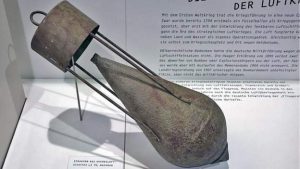
The first bomb (similar to the one pictured here) hit Alexandra Dock about 250 yards (230m) directly north of the coal conveyor.
(BBC Copyright: BBC)
It fell in a pile of pit props, scattering them and making a hole 10ft (3m) deep. Fragments pierced the metal of a nearby railway line and cut a telegraph pole in half.
2. Holy Trinity Church (now Hull Minster) was also bombed causing £100,000 in damage.
One bomb left a hole in the High Street, some 20 feet in diameter and 8 feet deep which disrupted traffic. After half an hour of bombing, the Zeppelin L.9, headed home around 12.20am. The air raid killed 24 Hull people and injured another 40 civilians. Among the deaths were a father and two daughters in Campbell Street, two children burnt to death in South Parade, two brothers in Blanket Row and a mother and son in Waller Street, Hull. The raid provoked much anti German feeling in Hull and led to riots, which targeted German sounding property.
On the 5th July 1915, the Government placed a 6 foot “wooden” gun, on the roof of the Rose Downs and Thompson factory at Cannon Street. It was guarded by two soldiers. It was intended to raise morale, but was removed on the 23rd January 1916, due to public pressure and disposed of. Its whereabouts now are unclear
Another raid by the Zeppelin L.9, intended for Hull on 9th August 1915, was blown off course and bombed Goole instead. It killed 16 civilians.
3. The 5th March 1916, was a snowy Sunday evening, when the air raid started at 12 midnight. Two Zeppelins, the L.11 & the L.14, unable to reach Rosyth in Scotland, due to high winds, began to bomb Hull instead. The attack lasted over an hour. In Queens Street, a café, a Co-operative branch and several shops were totally destroyed. Railings at the South West corner of Holy Trinity Church were uprooted and the great West window was broken causing £25,000 damage. Houses were bombed in Linnaeus Street, Porter Street, Queens Street, Church Street, and Selby Street. Earle’s Shipyard was also hit. In all 17 civilians were killed, including three Ingamell sisters, in Linnaeus Street and a mother and her 4 children at 32 Collier Street. There were also another 52 people injured.
The frustration of citizens at the complete lack of defences led to several disturbances. A Royal Flying Corp vehicle in Hull was stoned by an angry mob and a flying Officer was attacked in Beverley. As a result, mobile guns and searchlights arrived in Hull on 16th March 1916.
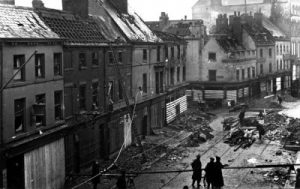
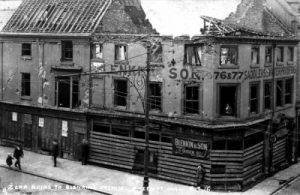
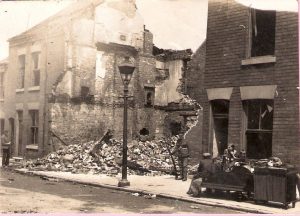
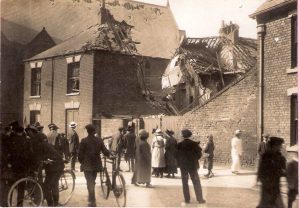
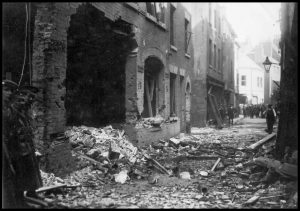
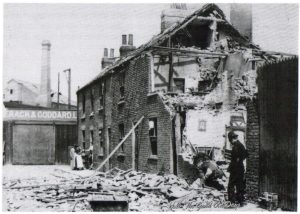
4. On 5th April 1916 at 9.10pm, the Zeppelin L.11 returned to Hull and at a height of 12,000 feet was caught in searchlights and hit. It dropped to about 6.000 feet. Only one bomb was dropped in Hull which damaged a private house in Portobello Street. No one was killed or injured, but Jesse Mathews from Barnsley Street died of shock.
5. On 8-9th August 1916, the Zeppelin L.24 attacked Hull. This later became known as the ‘Selby Street Raid’, killing between 8 or 10 people and injuring 20 more. It was a dark, cloudy Tuesday night, but when the clouds lifted at midnight, the Zeppelin L.24, returning home from an inland raid, attacked Hull at 1.15am. It dropped high explosive and incendiary bombs on Anlaby Road and the railway, causing damage and deaths in Selby Street, Sandringham Street and Linnaeus Street. The deaths included two mothers and their daughters and three year old John Broadley, at 4 Roland Avenue, Arthur Street. Two people also died of shock and another 20 civilians were injured. Many sought safety in the country and spent the night in fields and parks.
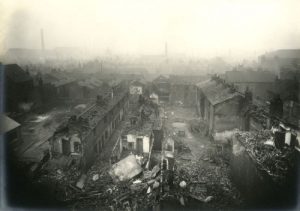
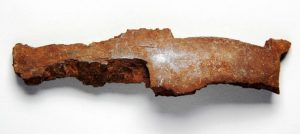
6. On 24th September 1917 at 2.50am, the Zeppelin L.41, dropped a total of 16 bombs on South Parade, St James Street, Landsdowne Street and Fountain Street. There was little damage. The only casualty was a chicken which unfortunately was killed.
7. Tuesday, 12th March 1918, was a dark, cloudy and drizzly night. At about 1.15am the Zeppelin L.63 appeared from Hornsea and dropped six bombs on Hull. These fell on some allotments in Southcoates Avenue, and damaged a large number of glass windows in the locality. Another six bombs fell in Sutton & Swine. The bombs killed a cow, damaged gardens in Cottingham and created a huge crater in Warne. One person died of shock and 3 were injured.
8. The 5th August 1918 was a Bank Holiday and the last recorded raid on Hull. It was very clear night and the Zeppelin arrived at about 1 am. It was caught in the search light and only managed to drop a smoke bomb before it was driven away. There were no casualties.
Hull endured up to 50 air raid warnings between 12th April 1915 to 5th August 1918. Most of the air raid warnings were false alarms, but Hull was unfortunate, as it became a target for many of the air raid attacks by accident when the zeppelins were unable to reach their intended target. The Raids left a trail of death and destruction. The following are some citizen stories reported in the Hull Daily Mail.
6th June 1915.- Eye Witness Accounts of Hull’s First Air raid
Mrs Websdale, of 23 Bright Street, said her husband was on duty as a Special Constable. Around midnight a bomb fell on no 30, but it did not wake her son who was asleep in the attic. Two bombs fells on Hewetson & Co’s sawmills and reduced it to ruins. The Zeppelin hovered over the area for some time and the Reckitt’s factory had a narrow escape from destruction. The extent of damage at the sawmills was £10,000 and a large amount of valuable machinery was destroyed. Mrs Bielby, of 1 Church Street, told how she and her family were sleeping, when a bomb dropped at the entrance of the terrace and shook the houses so violently that they had to be rebuilt. A huge hole was made in the ground.
Annie Nix, of 15 East Street, said that a bomb fell at Nos: 10 and 12, killing Jane (45) and George Hill who were in bed. They were taken to St Peter’s Church. Edward Jordan (10) of No: 11 Ella Street was also killed and three children Willie, Florrie and Elsie were injured. 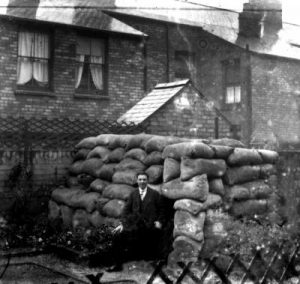
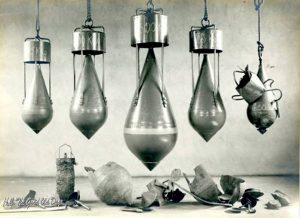
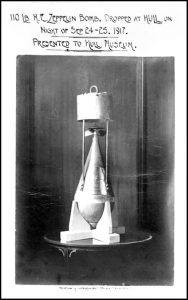
Mr Russell of Waller Street, said a bomb fell in the middle of Walter’s Terrace, demolishing 4 houses on each side. Eliza Slade (54) was killed at No 4, as were a mother and daughter at No; 3. Florence White (30) and her son George (3) and Alfred Mathews at No:11 were also killed. An incendiary bomb dropped on a house in Ellis Terrace and one woman did not find her three children until a fortnight later, when it was found that they had been badly injured and were in the Naval Hospital on Anlaby Road.
At South Parade, a bomb dropped at No:50, where two children were asleep with their mother. The children were burned to death, but the mother escaped. The children were Maurice (11) and Violet (8) Richardson. Their father was away in the army.
Three Houses in St Thomas Terrace, Campbell Street, were wrecked by a bomb falling on No: 2. William Walker (62), and his daughters Alice (30) and Millicent (17), were killed. One of the girls’ bodies was blown on to the lower roof of St Thomas’s Church, which had a narrow escape from destruction.
At Regent Street, an incendiary bomb was seen to fall in the back yard of Mr Francis Ford, of No: 89. He immediately got out of bed and threw a bucket of water on the blazing missile and extinguished it. This action undoubtedly, saved many lives and valuable property.
Mr Burns of Wheatley & Co, Mytongate, reported on the attack on the Corn Exchange Hotel. An Incendiary bomb went through the roof, ceiling and sitting room and finished in an upholstered divan chair. No doubt the copper springs in the chair lessened the shock of the fall, averting very serious damage. A fire started at the pub which was quickly extinguished on arrival of the fire brigade.
Coroners’ reports
It wasn’t just explosion and fire that killed people during the raid according to coroners’ reports. Several deaths were attributed to shock, fear and stress.
Coroners’ reports on several people aged from 36 to 67 included one which noted, “fatty degeneration of heart, accelerated by shock of German Zeppelin Air Raid”.
One person – the unfortunate Alfred Wonnison (or possibly Morrison), of Market Place – had his death attributed by the coroner to “shock after his wrongful arrest for being a German spy”.
It was noted he died of cardiac failure, accelerated by shock through being wrongfully arrested by two gunners.
Jane Ann Booth, 51, died at 2 Alma Street on the 24 July 1915. The coroner noted “vascular and cardiac disease present, accelerated by shock and fear of Zeppelin raid”.
An unusual casualty, was Private, Sidney Smith, 12th EYR, from 16, Bean Street, Hull. He was home on leave, during the 5th June 1915 and was traumatised by the air raid. His army medical records state that he had “Strong Emotional Shock, caused by the Air raid on the 5th June”. He was subsequently diagnosed as “Melancholic” and unable to carry out any normal duties. He was discharged from the army as permanently unfit, after 1 year and 303 days service, committed to the Willerby Asylum and died on 26th August 1918, aged 23. All this attributed to the Hull air raid on the 5th June 1915.
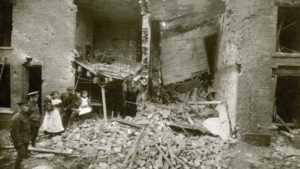
About 40 bombs in total fell on Hull during the raid. In Walter’s Terrace, off Waller Street, 14 houses were badly damaged, four of which collapsed, when they were hit by a bomb.
(Hull Museums Copyright: Hull Museums)
Four people were killed – three-year-old Isaac White and Florence White (31) at Number 3; Elizabeth Slade (55) at Number 4, and Alfred Matthew (50) at Number 11. The bomb crater was 18ft (5m) wide.
An incendiary bomb at neighbouring Ella’s Terrace penetrated two floors of the house at Number 3. it fell through the roof upstairs bedroom ceiling, the bedroom floor and front room floor. The fire was put out by neighbours with buckets of water and nobody was injured.
L-9 was now reported to be “at its greatest height”.As the Zeppelin made its way back to its base in Germany the city of Hull started to count the cost of the deadly raid.
During the 30 minutes of the attack 24 people had been killed and 40 injured. There were no casualties among the attackers.
In all 40 houses were destroyed.
City’s German community suffers retaliation
Dr Nick Evans, University of Hull writes following the raid, German pork butchers’ businesses across the city, like this one at 22 Princes Avenue (next to the PAVE pub), were targeted by people seeking revenge.
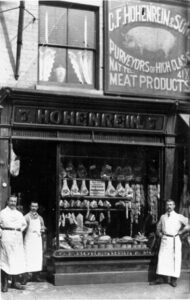
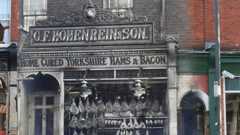
Shop windows were smashed and families were terrorised, threatened personally and often possessions were stolen in a response by the citizens of Hull to the horror they had witnessed.
At the outbreak of war in 1914 there was a vibrant community of about 1,000 Germans, but many left and by the end of the war it had dwindled to a few hundred people and the German community in Hull was damaged forever.
2nd September 1917.
John Ramsden, of Aberdeen Street said he saw the Zeppelin came to Hull from the east, but was driven away by gunfire. He later learned one of its petrol tanks had been shot away and found in a field in Hornsea.
12 March 1918.
Mrs Ellis, of Whitworth Street, Southcoates Lane, narrowly escaped death. She was walking towards the back door when a bomb fell in the rear garden. She heard a rushing sound and instantly threw herself to the ground, pulling her hat over her eyes. Pieces of the bomb went through the walls behind her, tore a huge piece of stonework from the front bedroom window ledge and threw it into the gateway. Every slate fell from the roof, but Mrs Ellis was unscathed.
Mrs Dick, of 62 Southcoates Avenue, said window frames were blown out and she found a large piece of bomb in her garden. The canary in its cage in front of the window was uninjured and was afterwards nicknamed ‘Zeppelin Dick’.
Miss Ellerby, of Southcoates Avenue, was in a cupboard when the bomb dropped. The walls were cracked and doors ripped off. Forty five buckets of debris were carried out of the front room.
As well as a number of Streets bombed and houses destroyed, some principal buildings damaged included Paragon Station, the Naval Hospital, Holy Trinity Church, and Earle’s Shipyard. Prominent Shops such Edwin Davis’s in the Market Place, Messrs J Good & Son, and Hewetson’s Saw Mills were destroyed. There were also some narrow misses at Ranks Flour Mill, Monument Bridge, Princes Dock and the new Guildhall. There were occasions were bombs failed to explode at Coltman Street, Bean Street and Argyle Street. In total, 43 Hull people were killed, 13 died of shock and 115 were injured in Zeppelin Air Raids on Hull. Amongst those killed were 21 women and 17 children, including several families.
In all, Zeppelins made 51 attacks on England, from a total of 159 air raids during the war. These killed 557 and injured another 1,358 people. Among the casualties was Mrs Lena Gilbert Ford, who wrote the patriotic war time song, ‘Keep the Home Fires Burning’. Mrs Ford and her thirty-year-old son Walter were the first United States citizens to become fatalities of a German air raid. Their London home being hit by one of two bombs, that fell on the city on 7 March 1918. Mrs. Brown, Ford’s mother, was only hurt in the bombing. Their remains were returned to and interred in the United States.
The use of German Gotha bombers began in May 1917 – these aircraft were capable of long distance flights and were used to make daylight raids on South East England. On 13 June 1917, German Gotha aircraft carried out an air raid on London – the first attack on London by a squadron of aircraft. Fourteen reached London, whilst three bombed Margate and Shoeburyness. At about 11.25am, bombs began to drop in the east end of London and in the City of London, bringing the highest casualties for any air raid on Britain in the war. Seventy two bombs were dropped within a one mile radius of Liverpool Street Station and in the east end, resulting in 162 civilian deaths and injuring 432 people. Between June 1917 and May 1918, Gotha bombers made a further seventeen attacks on London and other south eastern towns. The last aeroplane attack of the war occurred on the night of 19/20 May, with one further Zeppelin attack on the night of 5/6 August 1918.
In all, more than 5,000 bombs were dropped on towns across Britain, causing £1.5 million in damage. 84 airships took part, of which 30 were lost, either shot down or lost in accidents. Aeroplanes carried out 27 raids, dropping 246,774 lb (111,935 kg) of bombs for the loss of 62 aircraft, resulting in 835 deaths, 1,972 injured and £1,418,272 of material damage. The 159 German air raids against England in WWI, resulted in 1,413 deaths and 3,409 injuries, mostly civilians. Damage from Air Raids was estimated to cost some £3 million.
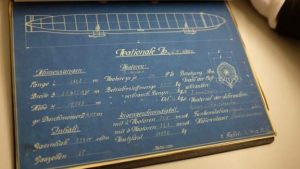
The brainchild of Count von Zeppelin, a retired German army officer, the flying weapon was lighter than air, filled with hydrogen and held together by a metal framework.
The Zeppelin that flew over the East Riding was capable of travelling at about 50mph (85kmph) and carrying up to two tonnes of bombs.
(Zeppelin Museum FriedrichshafenCopyright: Zeppelin Museum Friedrichshafen)
During their research into the 1915 attack, BBC Radio Humberside unearthed the actual blueprint (pictured) for the airship.
L-9, the craft that took part in the attack on Hull, was about 530ft (162m) long with a diameter of 53ft (16m).
The framework was originally wooden but by the time L-9 was built the frame had been replaced with aluminium.
Hull Civilians killed in Air Raids during World War One
(Names, Age in brackets and their Address)
June 1915
Maurice Richardson (11) – 50 South Parade
Violet Richardson (8) – 50 South Parade
Tom Stamford (46) – 5 Blanket Row
Ellen Temple (50) – 20 St James Square, St James Street
Elizabeth Picard Foreman (39) – 37 Walker Street
Sarah Ann Scott (86) – The Poplars, Durham Street
Johanna Harman (67) – 93 Arundel Street
Jane Hill (45) – 12 East Street
George Hill (48) – 12 East Street
Eliza Slade (54) – 4 Walter’s Terrace, Waller Street
Florence White (30) – 3 Waller Street
George Issac White (3) – 3 Waller Street
Alfred Mathews (60) – 11 Waller Street
William Walker (62) – 2 St Thomas Terrace, Campbell Street
Alice Priscilla Walker (30) – 2 St Thomas Terrace, Campbell Street
Millicent Walker (17) – 2 St Thomas Terrace, Campbell Street
Norman Mullins (10) – 39 Blanket Row
George Mullins (15) – 39 Blanket Row
William Watson (67) – 21 Edwin’s Place, Porter Street
Annie Watson (58) – 21 Edwin’s Place, Porter Street
Georgina Cunningham (27) – 22 Edwin’s Place, Porter Street
Emma Pickering (68) – Sarah’s Terrace, Porter Street
Edwin Jordan (10) – 11 East Street
Hannah Mitchell (42) – 5 Alexandra Terrace, Woodhouse Street
Sidney Smith (23) – 16 Bean Street (Died of Shock)
March 1916
Edward Cook (38) – 33 Lukes Street
John Longstaff (71) – 6 William’s Place, Upper Union Street
Lotte Ingamells (28) – 8 The Avenue, Linnaeus Street
Ethel Mary Ingamells (33) – 8 The Avenue, Linnaeus Street
Martha Rebecca Ingamells (35) – 8 The Avenue, Linnaeus Street
Edward Slip (45) – 23 Queen Street
Edward Ledner (89) – Trinity House, Carr Lane (Now the Admiral Pub)
Robert Cattle (48) – Little Humber Street
Frank Cattle (8) – Little Humber Street
James William Collinson (63) – 14 Johns Place, Regent Street
George Henry Youell (40) – 4 Post Office Entry, High Street
Charlotte Naylor (30) – 32 Collier Street
Ruby Naylor(8) – 32 Collier Street
Annie Naylor (6) – 32 Collier Street
Edward Naylor (4) – 32 Collier Street
Jeffery Naylor (2) – 32 Collier Street
James Pattison (68) – 33 Regent Street
John Smith (30) – 2 Queens Alley, Blackfriargate
August 1916
The Rev, Arthur Wilcockson (86) – 32 Granville Street
Mary Louise Bearpark (44) – 35 Selby Street
Emmie Bearpark (14) – 35 Selby Street
John Charles Broadley (3) – 4 Roland Avenue, Arthur Street
Rose Alma Hall (31) – 61 Selby Street
Elizabeth Hall (9) – 61 Selby Street
Mary Hall (7) – 61 Selby Street
Charles Lingard (64) – 61 Walliker Street
Emma Louise Evers (46) – 25 Brunswick Avenue, Walliker Street
Esther Stobbart (31) – 13 Henry’s Terrace, Wassand Street
Died of Shock
William Jones (80) – The Almshouses, Posterngate
Jane Booth (51) – 2 Alma Street
Sarah Masterman (58) – 9 Humber Avenue, Scarborough Street
William Clarkson (62) – 2 Adderbury Grove, Beverley Road
Jesse Mathews (1) – 11 Cotton Terrace, Barnsley Street
Related links –
Thank You to Robert Searle from the BBC, the Hull Daily Mail , ‘Hull: The Good Old days ‘(Facebook), Radio Humberside and others for their photographs. See also following Zeppelin Links